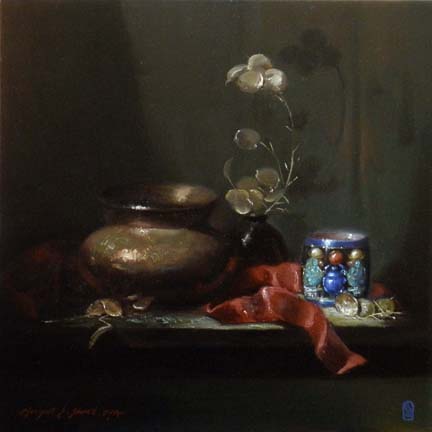Khepri’s Journey
Sold
14×14 Oil on Linen
© Margret E. Short 2009, OPA, AWA
Lessons from the Pharaoh’s Tomb
Lawrence Gallery, Portland, Oregon September & October 2009
As said before, when delving into a colorful history of any culture, you never know what will be unearthed. I just couldn’t resist using the motif of the stunning necklace (below) as inspiration for Khepri’s Journey. The recurring theme in this design is the rising sun-god which I incorporated into the decoration on the cup to the right. The lapis lazuli scarab represents the sun-god, khepri Scarab beetles lay their eggs which emerge from dung balls, hence the ancient Egyptians thought they came from nowhere. They believe that each day as the sun moved from east to west, the sun itself was pushed like a dung ball by khepri the scarab.
The curved gold shape under the scarab depicts the solar boat which was used for the night journey because khepri was swallowed each evening by the sky goddess. Khepri was reborn each morning. The ancients also believed each night the sun set into the Netherworld. Baboons would then aid the rising sun in its emergence each morning along with bringing up the dead from the Netherworld.
Egyptian blue, malachite, azurite, and red iron oxides were used here. The ribbon represents the “ribbon of life” and the bronze pot the enormity of the span of history.
Lawrence Gallery, Portland, Oregon


